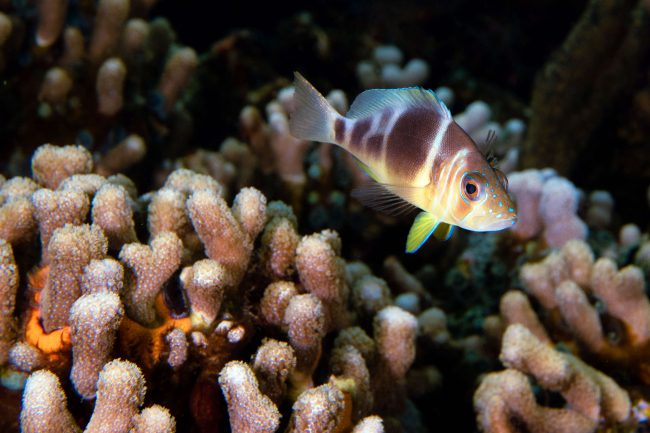06/09/2023 | In her project, Floriane Coulmance from the Fish Ecology and Evolution Unit is investigating the formation and evolutionary significance of colour patterns in the coral reef fish genus Hypoplectrus, the hamlets. As part of a study, she has developed a new method for the quantitative analysis of colour pattern variation. Here she reports about it.
What was the initial question of your study?
Floriane Coulmance: The initial question of the study was: What is the genetic basis of the phenotypic variation of the colour pattern in the fish genus Hypoplectrus? These are the hamlet fishes that live in coral reefs. Since colour patterns play a role in the ecology and evolution of coral reef fishes, it is important to know how they are created.
For example, the colour patterns are very important in the mate choice of hamlets because they ensure mating between individuals of the same species. The colour pattern is also involved in their mimicry behaviour: in this process, hamlets, which are territorial predators, try to resemble a non-predatory fish to increase their success in catching food.
Hamlets - our study model - have the highest documented speciation rates among reef fishes. If we now determine what variations in colour patterns exist between species, how they are formed, and what genetically underlies them, we might learn more about the evolutionary processes of their speciation. In particular, we are interested in what is known as sympatry, i.e. how species form when they are in the same geographical area or habitat.
What colour patterns can you find in hamlets?
Floriane Coulmance: There are 18 described species of hamlets that are distinguished almost entirely by their colour pattern. Pattern elements include vertical bars, a spot on the snout, a mark on the peduncle, a teardrop-shaped pattern under the eye, and also facial lines. Colour elements consist of hue, saturation, or colour gradients such as those from dorsal to ventral body parts. There are predominantly black, white, yellow and blue species. There are large differences in colour patterns between species.
What was the procedure for the study?
Floriane Coulmance: I characterized the colour pattern variations within the hamlet genus and between its species. To do this, I developed a new method for quantitative image analysis. My approach has the advantage of eliminating the bias of the human eye. Instead of looking at the photos themselves and defining the components of colour and pattern variation, we bring the standardized photos of the fish into a process that identifies multiple axes of variation and a representation of the pixels on the fish body that are involved in each specific axis of variation.
My method considers multiple traits rather than just one. I am able to use it to describe in detail the genetic components involved in colour pattern variation in hamlets. In addition, I am able to study the direct effect of specific genetic variants on the different colour patterns on the fish body.
What are the new findings?
Floriane Coulmance: Image analysis provides a quantitative analysis of the colour pattern elements of the hamlets. The most striking patterns are the vertical bars characteristic of barred hamlet species and the saddle on the caudal peduncle that characterizes butter hamlet species.
We also found three regions on the hamlet genome that appear to play an important role in the variation of their colour patterns. One region is located on chromosome 4 and the other two on chromosome 12.
What conclusions can be drawn from this?
Floriane Coulmance: Through image analysis, we identified several colour pattern elements: Colour of the face, body, ventral part, caudal fin and anal fin, vertical bars and saddle on the caudal peduncle. A striking aspect is that they are the basic "building blocks" of colour pattern variation in the overall radiation of hamlet species. Thus, the colour patterns of different species arise from different combinations of these basic elements.
Our genotype-phenotype study shows that each colour pattern element is associated with a relatively small number of gene loci, each of which has a large effect. This suggests a modular genetic and phenotypic architecture in which the diversity of colour patterns is generated by different combinations of alleles at these loci.
In addition, the high degree of overlapping geographic distribution of hamlets and the occurrence of hybridization in the group may contribute to the rapid generation of new phenotypic diversity. This mechanism may be responsible for the exceptionally rapid emergence of hamlet species.
What is the scientific relevance of the results?
Floriane Coulmance: This study is a proof-of-concept for the quantitative analysis of colour pattern variation in reef fishes. The results illustrate the potential of our approach to decompose colour pattern variation into interpretable colour pattern elements and identify the underlying genetic mechanisms.
In larger samples, this method can be used to identify more subtle colour pattern variation within species and provide the basis for studying the eco-evolutionary significance of colour patterns in reef fishes.
What are the next plans for the project?
Floriane Coulmance: Next, I will examine the genes we have associated with colour pattern variation in hamlets in this study in a phylogenetic context. With a new data set, I can ask questions about the evolutionary history of hamlets and see if the colour pattern genes have followed the species history. I can also ask questions about the phenotypes of the ancestors of the hamlets.
Publication
Coulmance, F., Akkaynak, D., Le Poul, Y., Höppner, M. P., McMillan, W. O., & Puebla, O. (2023). Phenotypic and genomic dissection of colour pattern variation in a reef fish radiation. Molecular Ecology, 00, 1–15. https://doi.org/10.1111/mec.17047





